An Efficient Energy Management in Office Using Bio-Inspired Energy Optimization Algorithms
Abstract
1. Introduction
2. Related Work
3. Problem Statement and Approach
4. System Model and Problem Formulation
4.1. Model Architecture
4.2. Problem Formulation
- Power capacities of consumers in every time interval are mapped as U number of knapsacks;
- Appliances in an office are mapped as “Q” number of objects;
- The weight of every object in MKP is mapped as appliances’ consumed energy in every time interval. This is assumed to be time invariant;
- In MKP, the worth of each object in a particular time interval is mapped as the cost of appliances’ consumed energy in that interval of time [29].
4.3. The Electricity Cost
4.4. The Power Consumption
4.5. PAR
4.6. Waiting Time
4.7. Objective Function
5. Scheduling Algorithms
5.1. Grasshopper Optimization Algorithm
| Algorithm 1: GOA algorithm. |
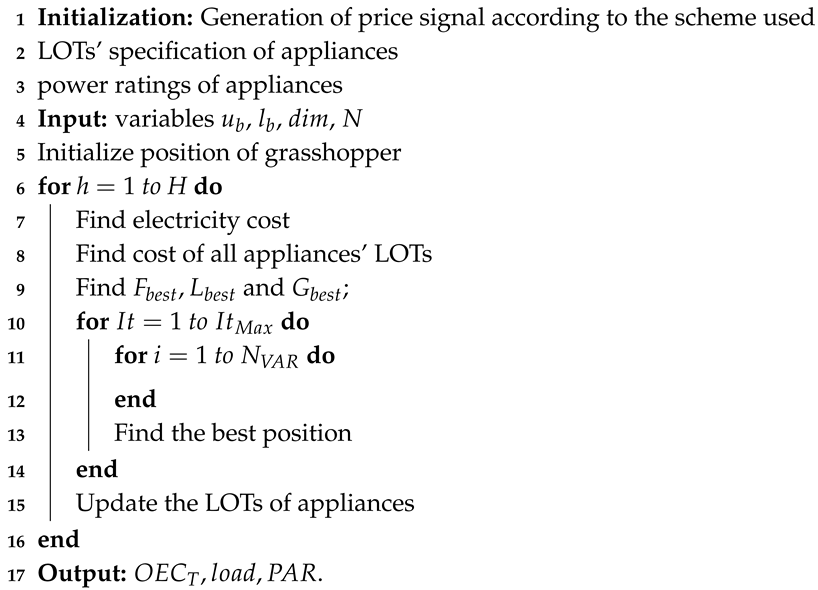 |
5.2. Bacterial Foraging Algorithm
- (a)
- Chemotaxis
- (b)
- Swarming
- (c)
- Reproduction
- (d)
- Elimination
5.2.1. Chemotaxis
5.2.2. Swarming
5.2.3. Reproduction
5.2.4. Elimination and Dispersal
| Algorithm 2: Bacterial foraging algorithm. |
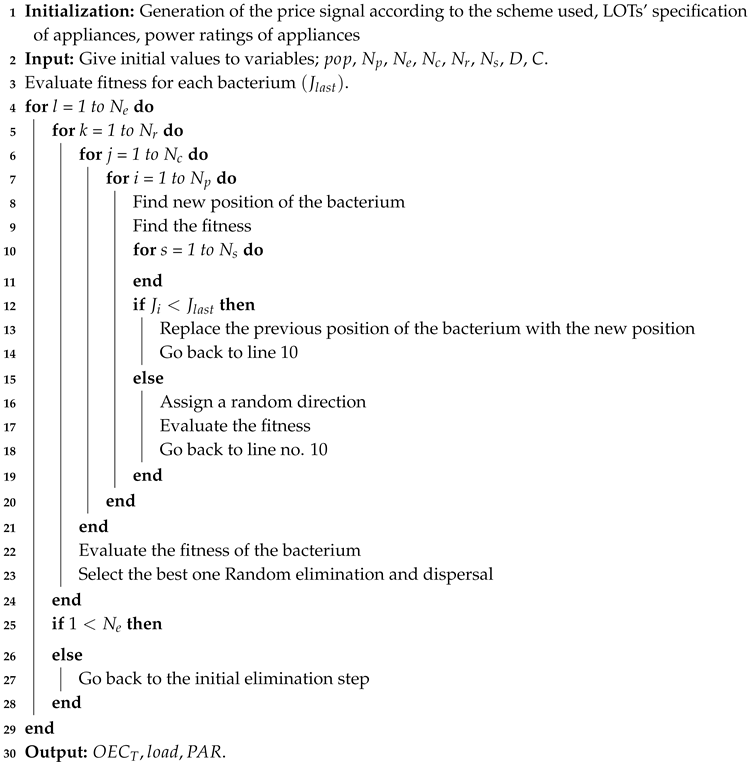 |
6. Simulation Results
7. Conclusions
Author Contributions
Funding
Conflicts of Interest
Abbreviations
| OEC | Office energy consumption |
| LOT | Length of operational time |
| OTI | Operational time interval |
| AOAs | Automatically operating appliances |
| PAR | Peak-to-average power ratio |
| Un-sch | Un-scheduled load |
| FA | Firefly algorithm |
| CSA | Cuckoo search algorithm |
| ACO | Ant colony optimization |
| s | Each time slot |
| C | The total electricity cost in sixty time slots |
| Power rating of connected appliances | |
| Power consumption of each appliance | |
| Waiting time for an appliance | |
| S | Set of 60 time slots |
| Energy cost per hour | |
| X | ON-OFF states of an appliance |
| Starting time of an appliance | |
| Operational starting time of an appliance | |
| Ending time of an appliance |
References
- Hashmi, M.; Hnninen, S.; Mki, K. Survey of smart grid concepts, architectures, and technological demonstrations world-wide. In Proceedings of the IEEE PES Conference on Innovative Smart Grid Technologies (ISGT Latin America), Medellin, Colombia, 19–21 October 2011; pp. 1–7. [Google Scholar]
- Rahimi, F.; Ipakchi, A. Demand response as a market resource under the smart grid paradigm. IEEE Trans. Smart Grid 2010, 1, 82–88. [Google Scholar] [CrossRef]
- Ahmed, A.; Manzoor, A.; Khan, A.; Zeb, A.; Ahmad, H. Performance Measurement of Energy Management Controller Using Heuristic Techniques. In Proceedings of the Conference on Complex, Intelligent, and Software Intensive Systems, Turin, Italy, 10–13 July 2017; pp. 181–188. [Google Scholar]
- Ozturk, Y.; Senthilkumar, D.; Kumar, S.; Lee, G. An intelligent home energy management system to improve demand response. IEEE Trans. Smart Grid 2013, 4, 694–701. [Google Scholar] [CrossRef]
- Mavrotas, G.; Karmellos, M. Multi-objective optimization and comparison framework for the design of Distributed Energy Systems. Energy Convers. Manag. 2019, 180, 473–495. [Google Scholar]
- Sousa, T.; Morais, H.; Vale, Z.; Faria, P.; Soares, J. Intelligent energy resource management considering vehicle-to-grid: A simulated annealing approach. IEEE Trans. Smart Grid 2012, 3, 535–542. [Google Scholar] [CrossRef]
- Soares, J.; Sousa, T.; Morais, H.; Vale, Z.; Faria, P. An optimal scheduling problem in distribution networks considering V2G. In Proceedings of the IEEE Symposium on Computational Intelligence Applications in Smart Grid (CIASG), Paris, France, 11–15 April 2011; pp. 1–8. [Google Scholar]
- Tsui, K.M.; Chan, S.C. Demand response optimization for smart home scheduling under real-time pricing. IEEE Trans. Smart Grid 2012, 3, 1812–1821. [Google Scholar] [CrossRef]
- Zhao, Z.; Lee, W.C.; Shin, Y.; Song, K.B. An optimal power scheduling method for demand response in home energy management system. IEEE Trans. Smart Grid 2013, 4, 1391–1400. [Google Scholar] [CrossRef]
- Arabali, A.; Ghofrani, M.; Etezadi-Amoli, M.; Fadali, M.S.; Baghzouz, Y. Genetic-algorithm-based optimization approach for energy management. IEEE Trans. Power Deliv. 2013, 28, 162–170. [Google Scholar] [CrossRef]
- Tang, L.; Zhao, Y.; Liu, J. An improved differential evolution algorithm for practical dynamic scheduling in steelmaking-continuous casting production. IEEE Trans. Evol. Comput. 2014, 18, 209–225. [Google Scholar] [CrossRef]
- Liu, B.; Kang, J.; Jiang, N.; Jing, Y. Cost control of the transmission congestion management in electricity systems based on ant colony algorithm. Energy Power Eng. 2011, 3, 17. [Google Scholar] [CrossRef]
- Khalid, A.; Javaid, N.; Mateen, A.; Khalid, B.; Khan, Z.A.; Qasim, U. Demand Side Management using Hybrid Bacterial Foraging and Genetic Algorithm Optimization Techniques. In Proceedings of the 10th International Conference on Complex, Intelligent, and Software Intensive Systems (CISIS), Fukuoka, Japan, 6–8 July 2016; pp. 494–502. [Google Scholar]
- Wang, K.; Li, H.; Maharjan, S.; Zhang, Y.; Guo, S. Green Energy Scheduling for Demand Side Management in the Smart Grid. IEEE Trans. Green Commun. Netw. 2018, 2, 596–611. [Google Scholar] [CrossRef]
- Ullah, I.; Hussain, S. Time-Constrained Nature-Inspired Optimization Algorithms for an Efficient Energy Management System in Smart Homes and Buildings. Appl. Sci. 2019, 9, 792. [Google Scholar] [CrossRef]
- Aslam, S.; Bukhsh, R.; Khalid, A.; Javaid, N.; Ullah, I.; Fatima, I. An Efficient Home Energy Management Scheme Using Cuckoo Search. In Proceedings of the International Conference on P2P, Parallel, Grid, Cloud and Internet Computing, Taichung, Taiwan, 27–29 October 2018; pp. 167–178. [Google Scholar]
- Yang, X.-S.; Suash, D. Cuckoo search via Lévy flights. In Proceedings of the 2009 World Congress on Nature & Biologically Inspired Computing (NaBIC), Coimbatore, India, 9–11 December 2009; pp. 210–214. [Google Scholar]
- Manzoor, A.; Javaid, N.; Ullah, I.; Abdul, W.; Almogren, A.; Alamri, A. An Intelligent Hybrid Heuristic Scheme for Smart Metering based Demand Side Management in Smart Homes. Energies 2017, 10, 1258. [Google Scholar] [CrossRef]
- Gao, R.; Wu, J.; Hu, W.; Zhang, Y. An improved ABC algorithm for energy management of microgrid. Int. J. Comput. Commun. Control 2018, 13, 477–491. [Google Scholar] [CrossRef]
- Shirazi, E.; Jadid, S. Optimal residential appliance scheduling under dynamic pricing scheme via HEMDAS. Energy Build. 2015, 93, 40–49. [Google Scholar] [CrossRef]
- Adika, C.O.; Wang, L. Smart charging and appliance scheduling approaches to DSM. Int. J. Electr. Power Energy Syst. 2014, 57, 232–240. [Google Scholar] [CrossRef]
- Huang, Y.; Wang, L.; Guo, W.; Kang, Q.; Wu, Q. Chance Constrained Optimization in a Home Energy Management System. IEEE Trans. Smart Grid 2018, 9, 252–260. [Google Scholar] [CrossRef]
- Javaid, N.; Hussain, S.M.; Ullah, I.; Noor, M.A.; Abdul, W. Demand Side Management in Nearly Zero Energy Buildings Using Heuristic Optimizations. Energies 2017, 10, 1131. [Google Scholar] [CrossRef]
- Ma, K.; Hu, S.; Yang, J.; Xu, X.; Guan, X. Appliances scheduling via cooperative multi-swarm PSO under day-ahead prices and photovoltaic generation. Appl. Soft Comput. 2018, 62, 504–513. [Google Scholar] [CrossRef]
- Asgher, U.; Rasheed, B.; Saad, A.; Rahman, A.; Alamri, A. Smart Energy Optimization Using Heuristic Algorithm in Smart Grid with Integration of Solar Energy Sources. Energies 2018, 11, 3494. [Google Scholar] [CrossRef]
- Bharathi, C.; Rekha, D.; Vijayakumar, V. Genetic Algorithm Based Demand Side Management for Smart Grid. Wirel. Pers. Commun. 2017, 93, 481–502. [Google Scholar] [CrossRef]
- Shi, K.; Li, D.; Gong, T.; Dong, M.; Gong, F.; Sun, Y. Smart Community Energy Cost Optimization Taking User Comfort Level and Renewable Energy Consumption Rate into Consideration. Processes 2019, 7, 63. [Google Scholar] [CrossRef]
- Liu, Y.; Yuen, C.; Huang, S. Peak-to-Average Ratio Constrained Demand-Side Management with Consumer’s Preference in Residential Smart Grid. IEEE J. Sel. Top. Signal Process. 2014, 8, 1084–1097. [Google Scholar] [CrossRef]
- Yang, X.S. Firefly algorithms for multimodal optimization, in Stochastic Algorithms: Foundations and Applications. Lect. Notes Comput. Sci. 2009, 5792, 169–178. [Google Scholar]
- Saremi, S.; Mirjalili, S.; Lewis, A. Grasshopper optimization algorithm: Theory and application. Adv. Eng. Softw. 2017, 105, 30–47. [Google Scholar] [CrossRef]
- Simpson, S.J.; McCaffery, A.; HAeGELE, B.F. A behavioural analysis of phase change in the desert locust. Biol. Rev. 1999, 74, 461–480. [Google Scholar] [CrossRef]
- Rogers, S.M.; Matheson, T.; Despland, E.; Dodgson, T.; Burrows, M.; Simpson, S.J. Mechanistically-induced behavioural gregarization in the desert locust Schistocerca gregaria. J. Exp. Biol. 2003, 206, 3991–4002. [Google Scholar] [CrossRef] [PubMed]
- Topaz, C.M.; Bernoff, A.J.; Logan, S.; Toolson, W. A model for rolling swarms of locusts. Eur. Phys. J. Spec. Top. 2008, 157, 93–109. [Google Scholar] [CrossRef]
- Passino, K.M. Biomimicry of bacterial foraging for distributed optimization and control. IEEE Control Syst. 2002, 22, 52–67. [Google Scholar]
- Day-Ahead Pricing (DAP). NYISO (New York Independent System Operator). Available online: http://www.energyonline.com/Data/GenericData.aspx?DataId=11&NYISO-Day-Ahead-Energy-Price (accessed on 25 January 2019).


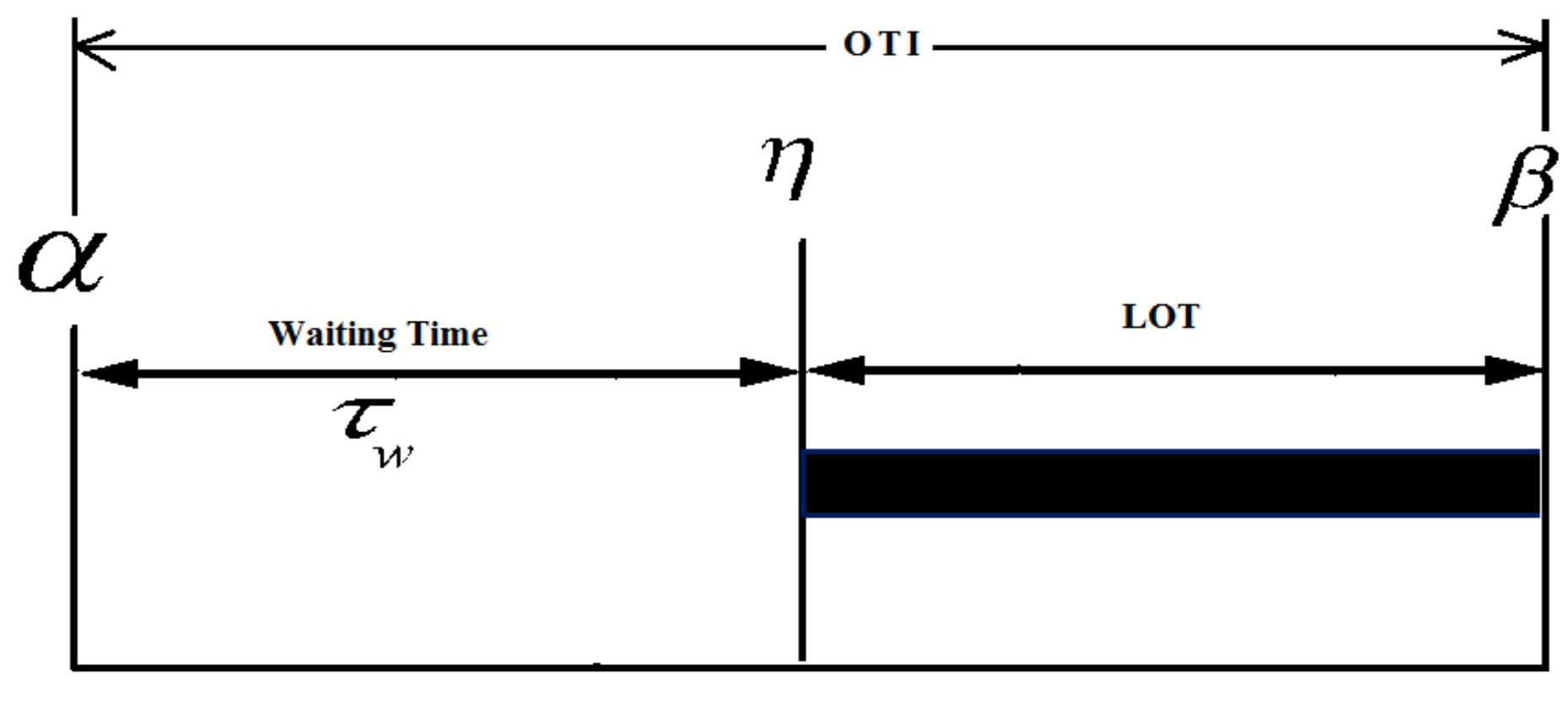






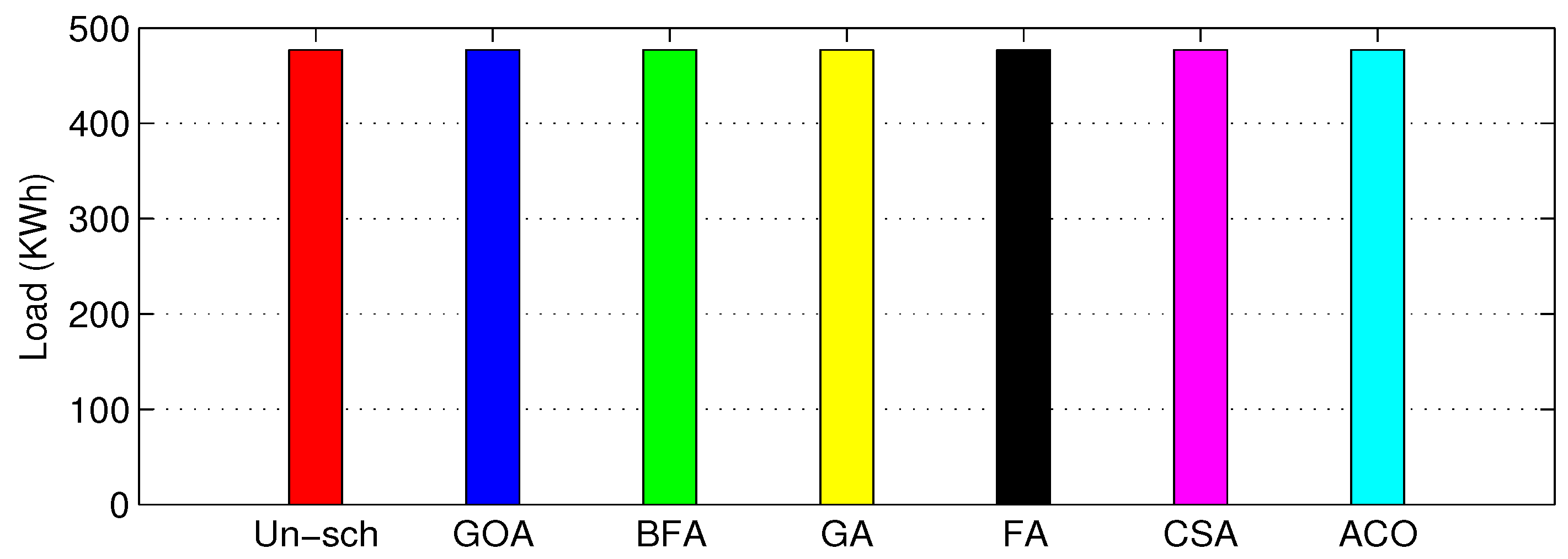

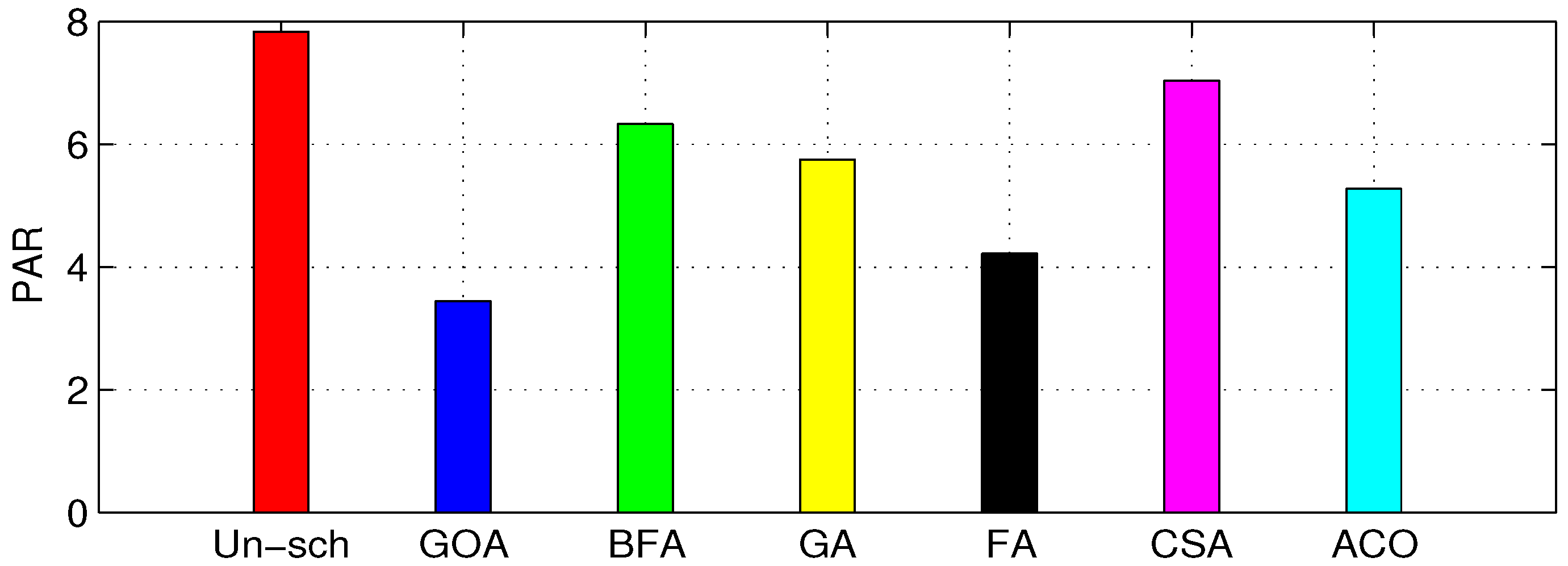
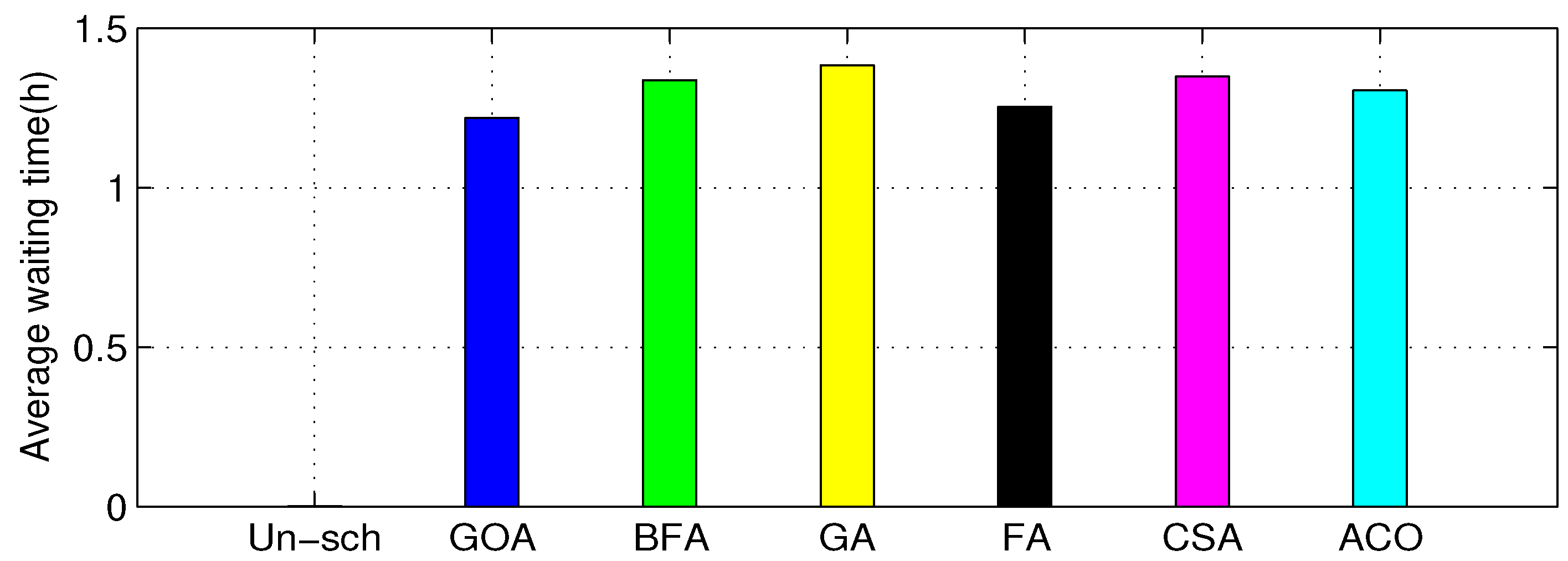
| S. No. | AOAs | LOT | Power Rating (kW) | OTIs |
|---|---|---|---|---|
| 1 | Air conditioner | 30 | 4.00 | 1–60 |
| 2 | Computer | 40 | 0.25 | 5–55 |
| 3 | Electric kettle | 2 | 3.00 | 1–55 |
| 4 | Coffee maker | 3 | 2.00 | 10–45 |
| 5 | Water dispenser | 45 | 2.5 | 1–60 |
| 6 | Oven | 5 | 5.00 | 10–50 |
| 7 | Fan | 25 | 3.5 | 1–60 |
| 8 | Light | 35 | 2 | 1–60 |
| Techniques | Days | Cost ($) | Cost Reduction | Waiting Time (h) | PAR | PAR Change |
|---|---|---|---|---|---|---|
| Unschedule | 30 days | 267.45 | – | – | 7.81 | – |
| GOA-scheduled | 30 days | 174.67 | 34.69% | 1.28 | 3.42 | 56.20% |
| BFA-scheduled | 30 days | 161.23 | 37.47% | 1.32 | 6.18 | 20.87% |
| GA-scheduled | 30 days | 150.07 | 43.89% | 1.39 | 5.84 | 25.22% |
| FA-scheduled | 30 days | 177.39 | 33.68% | 1.25 | 4.17 | 46.60% |
| CSA-scheduled | 30 days | 147.68 | 44.79% | 1.38 | 7.11 | 08.96% |
| ACO-scheduled | 30 days | 176.83 | 33.89% | 1.27 | 5.34 | 31.62% |
| Proposed Algorithm | No. of Days | Run-Time (s) |
|---|---|---|
| GOA | 30 days | 11.695 |
| BFA | 30 days | 13.171 |
© 2019 by the authors. Licensee MDPI, Basel, Switzerland. This article is an open access article distributed under the terms and conditions of the Creative Commons Attribution (CC BY) license (http://creativecommons.org/licenses/by/4.0/).
Share and Cite
Ullah, I.; Khitab, Z.; Khan, M.N.; Hussain, S. An Efficient Energy Management in Office Using Bio-Inspired Energy Optimization Algorithms. Processes 2019, 7, 142. https://doi.org/10.3390/pr7030142
Ullah I, Khitab Z, Khan MN, Hussain S. An Efficient Energy Management in Office Using Bio-Inspired Energy Optimization Algorithms. Processes. 2019; 7(3):142. https://doi.org/10.3390/pr7030142
Chicago/Turabian StyleUllah, Ibrar, Zar Khitab, Muhammad Naeem Khan, and Sajjad Hussain. 2019. "An Efficient Energy Management in Office Using Bio-Inspired Energy Optimization Algorithms" Processes 7, no. 3: 142. https://doi.org/10.3390/pr7030142
APA StyleUllah, I., Khitab, Z., Khan, M. N., & Hussain, S. (2019). An Efficient Energy Management in Office Using Bio-Inspired Energy Optimization Algorithms. Processes, 7(3), 142. https://doi.org/10.3390/pr7030142






